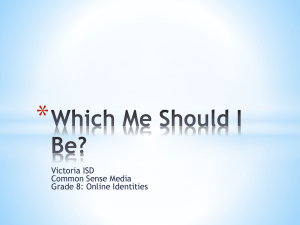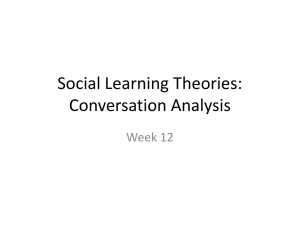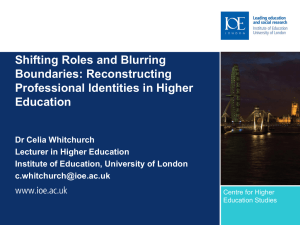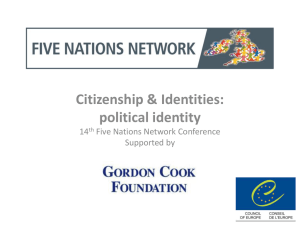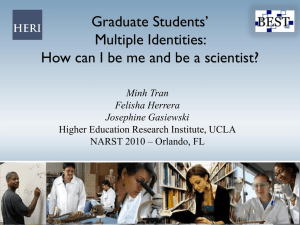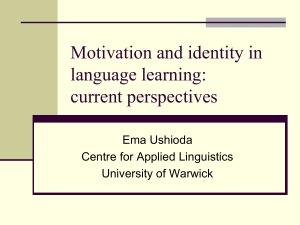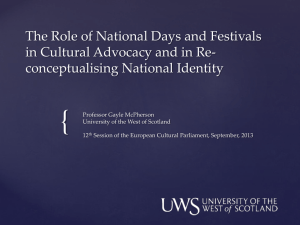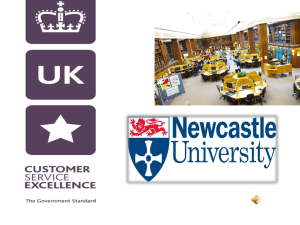B.A. (Hons) Language, Literacy and Communication
advertisement
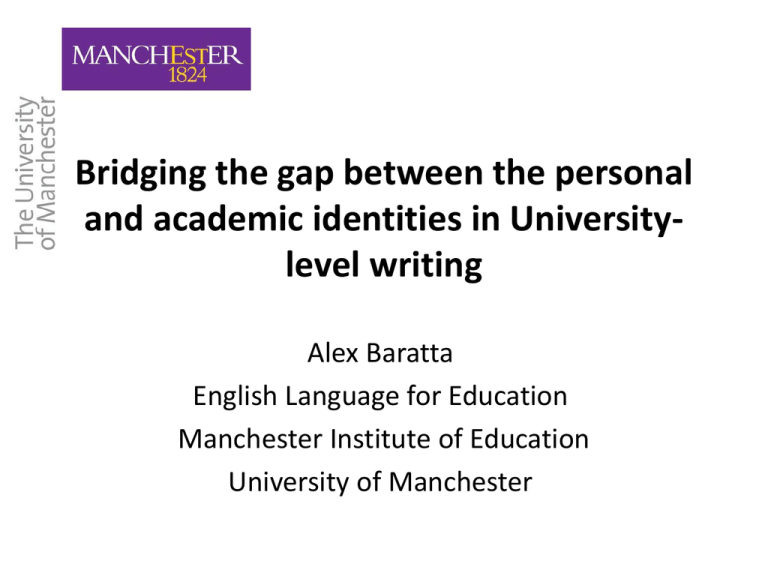
Bridging the gap between the personal and academic identities in Universitylevel writing Alex Baratta English Language for Education Manchester Institute of Education University of Manchester Background • The transition from Sixth-Form College to university can be challenging for many reasons, with the demands of university-level academic writing being one of them • From my teaching experiences, a common issue for many students is writing in a manner that is more indicative of a personal style, yet is at odds with the academic style we expect them to write in • Therefore, I wanted to discover how students can write in a manner that befits both the academy and their own personality – is there a way for students to please both themselves and the academy? • Regarding the ‘academy’, however, we need to take into consideration the discipline one is writing for, as well as the particular genre of essay – something historically absent in US writing classes Students’ Concerns • Fairclough (1995:227) calls the transition from a personal self to an academic one ‘an uncomfortable and alienating experience’ • One major factor is that students are not always certain how they should write in terms of whether the writing should be personal or impersonal • Schleppegrell (2001:435) states that students must present themselves as ‘detached’; Hyland (2002:1091) states, however, that academic writing ‘is not completely impersonal’ • In the Freshman Composition context, students fear having their creativity put ‘in a straightjacket’ (Wyrick, 2002:xi) • So ‘how can our students find their own voice and become comfortable with it?’ (Neman, 1995:217) My Writing Class The writing provision is twofold, delivered in semester one of year one: – A hands-on ‘how to write’ class, Introduction to Academic Writing and Digital Study Skills – The course unit Reading and Writing Processes introduces students to the more theoretical side of writing – My goal is to join the two together and help students strive to become better writers by visualising themselves attaining an academic identity with regard to the writing they produce – But not losing their personal identity within their writing in the process! The literature background Ivanic (1998) argues in favour of identities being socially constructed, in keeping with the work of Bruner (1983), Tajfel (1978), Hecht et al (2001) and Joseph (2004); a broad factor here is that there is an identity inherent in our writing and by virtue of this, an identity that is constructed by the reader (we must also consider that some choices in writing are subconscious). – This suggests that we are not in complete control of the identities we construct and use – Ivanic discusses an identity crisis of sorts for individuals entering higher education, based on a mismatch between their true identity and the identity that they are expected to take on in order to succeed in academia – This identity is based on, at least within writing, adhering to the norms, values and goals expected in the production of ‘good’ academic texts – Do we consider adopting such an academic identity in our writing as a case of ‘selling out’, ‘playing the game’ or something we eagerly seek? Two core identities The Autobiographical Self • This self is based on one’s roots and forged from personal experience, roles, opinions, beliefs and interests – perhaps the most authentic self, albeit one made up of numerous voices. Ivanic references the identity inherent with a tall, deaf woman from a wealthy Nigerian family who lives in the northwest and who will have a core identity forged from all these various aspects of who she is. Her belief systems will be varied, but largely reflective of ‘people like her’ (Ivanic, 1998:182) • Ivanic also cites a black, British woman whose autobiographical self demanded she use ‘we’ when writing about black women in Europe; her academic self, however, prevailed, forcing her to use the pronoun ‘they’ instead ‘When I was 16 my family moved to England. This had a great impact on my language as I was forced to communicate in a language that I was not very confident in, especially not with the terminology used in the different lessons at school and among the people my age’ Possibilities for Self-Hood • These are the various identities that are available to writers within their community, some more privileged than others, based on the status quo regarding power structures and resulting norms and values • However, I consider this essentially to refer to the various ways individuals can write, in a manner that reflects an academic identity (for both reader and writer) and reveals the personal side of the writer too • These possibilities, unique to each student, are those that are focused on in terms of the concept of taking on a new identity Example On my last visit Ms A admitted to me that she was better off without her cohab. as the fear and threat of violence was reduced. However, during those few weeks when she was ‘cohab-free’ Ms A had been struck by a greater fear, loneliness – The use of the quotation marks signals ‘this is mine, and it’s partly me’ (page 151), thus a link to the autobiographical self – but if not proscribed within the department (Sociology), then a link to a possible self-hood, thus the two identities peacefully co-existing Samples of Students’ Writing • All literate societies read newspapers • Each of us has his or her own unique ‘linguistic fingerprints’ • Something that struck me throughout the exchange was that written words carry a great deal more power than spoken words. Once said, spoken words are forgotten, even though the content is usually remembered it is rare that the exact words are. However, when words are written down they can be looked at time and time again, and almost become ‘cringe-worthy’, seeming more and more unnatural every time they are read • Unlike their Anglo-American counterparts, Mexican-American immigrant children are poor • During my childhood, and even to this day, there has always been a strong emphasis placed on how I ‘should’ speak by my immediate family Implications • This is not just about looking at students’ texts as a guide to how to write – this is indeed nothing new perhaps • Rather, by starting with the concept of identity, both personal and academic, as well as the background knowledge of the discipline, students are enabled to analyse texts from a more concrete perspective • The concept of an academic identity can arguably benefit visual learners, perhaps by activating relevant schema with regard to the key word of ‘academic’ • Further, analysing text samples based on identity issues allows for much more critical thinking, a skill which students must develop (but one that is arguably difficult to teach) References Bruner, Jerome. 1983. Child’s talk: Learning to use language. Oxford: Oxford University Press. Fairclough, Norman. 1995. Critical discourse analysis. Boston: Addison Wesley. Hecht, Michael, Ronald Jackson, Sheryl Lindsley, Susan Strauss & Karen Johnson. 2001. A layered approach to communication: Language and communication. In W. Peter Robinson & Howard Giles (eds.), The new handbook of language and social psychology, 429-449. Chichester: John Wiley and Sons. Hyland, Ken. 2002. Teaching and researching writing. London: Longman. Ivanic, Roz. 1998. Writing and identity: The discoursal construction of identity in academic writing. Philadelphia: John Benjamins. Joseph, John. 2004. Language and identity. New York: Palgrave Macmillan. Neman, Beth. 1995. Teaching students to write. London: Oxford University Press. Schleppegrell, Mary. 2001. Linguistic features of the language of schooling. Linguistics and Education 12(4): 431–459. Tajfel, Henri. 1978. Social categorization, social identity and social comparison. In Henri Tajfel (ed.), Differentiation between social groups: Studies in the social psychology of intergroup relations, 61-76. London: Academic Press. Wyrick, Jean. 2002. Steps to writing well. Fort Worth, TX: Harcourt Brace Publishers.

